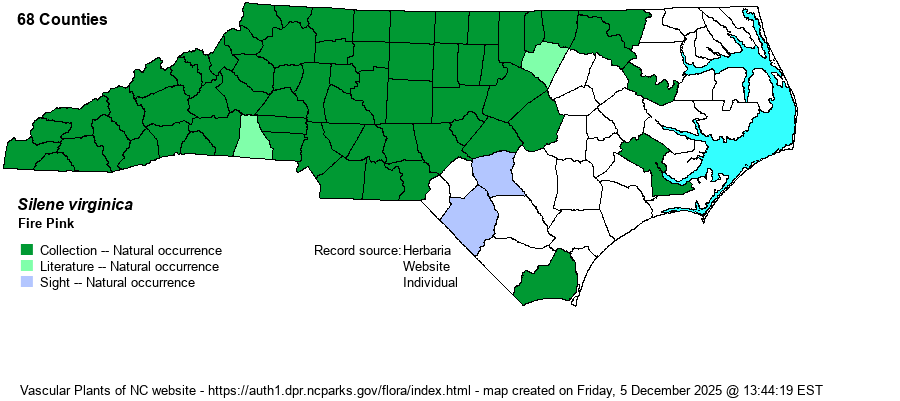| Author | L. | |
| Distribution | Throughout the Mountains and Piedmont; ranges sparingly into the western Coastal Plain, mostly along brownwater rivers, to Martin and Robeson counties, and disjunctly to Craven County.
This is a widespread species, with the bulk of its range mostly from the Appalachians westward. It occurs from southern NY and MN south to the FL Panhandle and northeastern TX. It is scarce on the Coastal Plains. | |
| Abundance | Common in the Mountains and western Piedmont; fairly common in most of the rest of the Piedmont. Rare to locally uncommon in the western parts of the Coastal Plain. This is the most numerous Silene in the Mountains and western Piedmont, though the overlooked S. antirrhina is probably more numerous in the rest of the state. | |
| Habitat | This species has a wide array of forested to partly forested habitats, usually in dry, mesic, and/or rocky places. It grows in upland woods, rocky woods, roadbanks and wooded borders, on cliff crevices, and around various outcrops. However, farther into the eastern Piedmont and Coastal Plain, it favors more mesic to rich forested habitats, usually on banks or slopes. | |
| Phenology | Blooms from April to July, and fruits shortly after flowering. | |
| Identification | This is one of the more familiar and popular wildflowers in the state, known to nearly everyone who ventures into the woods. This species often has basal branching, and each stem grows erect to about 1.5 feet tall, with a sticky stem in between the leaf nodes. It has a few pairs of stem leaves, each spatulate or oblanceolate, about 4 inches long and 1-inch wide, tapering to the stem. Each branch or stem has only a few scattered flowers, each bright red, with a corolla tube and 5 flaring lobes, with a flower spread about 1.5 inches across, larger than essentially all others in the genus. The apex of each lobe is strongly cleft, not that forking of the end of each lobe in necessary for identification! The species often grows in moderate stands, though not in dense patches, and many a forested roadbank is "painted" bright red when these plants are in bloom. | |
| Taxonomic Comments | Most references do not list varieties, but Weakley (2018) does, with the nominate one being the only one in NC.
| |
| Other Common Name(s) | None | |
| State Rank | S5 | |
| Global Rank | G5 | |
| State Status | | |
| US Status | | |
| USACE-agcp | | |
| USACE-emp | | |

